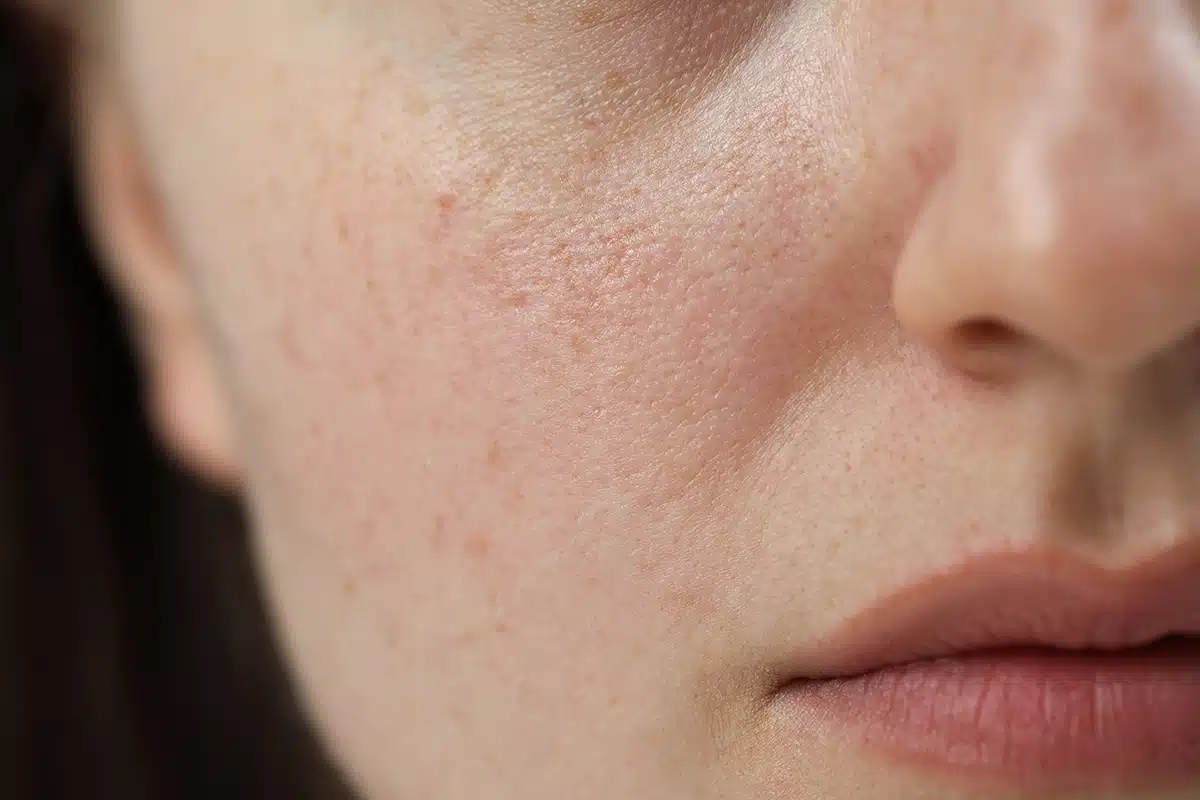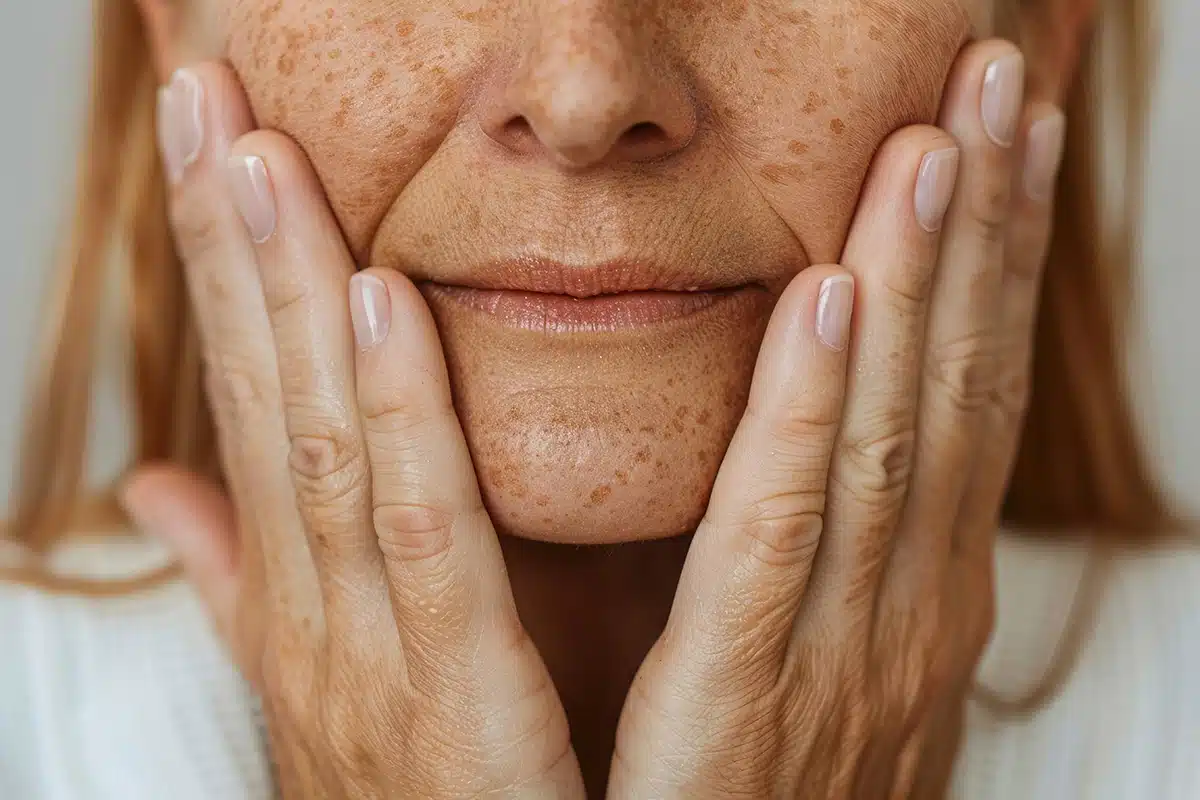What is Hyperpigmentation?

Hyperpigmentation refers to the darkening or discoloration of the skin, which occurs when an excess amount of melanin, the pigment responsible for skin color, is produced or unevenly distributed in certain areas.
This condition can manifest as small spots, larger patches, or skin darkening. Various factors, such as sun exposure, hormonal changes, acne scars, inflammation, or certain medications, can cause hyperpigmentation. It is commonly seen in individuals with darker skin tones.
Discoloration of the skin can significantly impact one’s self-esteem and confidence, as it can be aesthetically displeasing.
Fortunately, several treatment options are available, including topical creams, chemical peels, laser therapy, and microdermabrasion, that can help reduce or even out skin discoloration, restoring a more even and radiant complexion.
At Sempre Day & Medical Spa, we understand the concerns and challenges of hyperpigmentation. Hyperpigmentation refers to the darkening of certain areas of the skin resulting from excess melanin production.
What Are the 3 main types of Hyperpigmentation?
Understanding the different types of hyperpigmentation is vital for developing effective treatment plans tailored to each individual’s needs.
Our experienced aestheticians and medical professionals at Sempre Day & Medical Spa are equipped with advanced skincare techniques And treatments to address hyperpigmentation and help our clients achieve clearer, more even-toned skin.
From laser therapy and chemical peels to customized skincare regimens, we strive to provide the best solutions while prioritizing our clients’ skin health and enhancing their natural beauty.
1. Melasma
Melasma is a common type of hyperpigmentation that primarily affects women and usually appears on the face. However, it can occur in other areas.
It is often characterized by symmetrical patches of dark brown or grayish pigmentation. Melasma is primarily triggered by hormonal changes, such as pregnancy or the use of oral contraceptives, or sun exposure.
2. Post-inflammatory Hyperpigmentation
Post-inflammatory hyperpigmentation (PIH) occurs when there is an overproduction of melanin as a result of inflammation or injury to the skin. This type of hyperpigmentation commonly appears as dark spots or patches that linger after acne breakouts, burns, cuts, or other skin traumas have healed.
PIH can affect individuals with all skin types, but it is more noticeable in individuals with darker skin tones.
3. Sun Spots (Solar Lentigines)
Also known as liver spots or age spots, sun spots are a type of hyperpigmentation that develops due to long-term exposure to the sun’s harmful UV rays.
These spots typically appear on areas of the skin that are frequently exposed to the sun, such as the face, hands, arms, and shoulders. Sunspots are flat and have a range of colors, including brown, tan, or black.
Who Is Affected by Hyperpigmentation?
Hyperpigmentation is a common skin condition that affects people of various backgrounds and skin types. While it can occur in any individual, certain factors may make some individuals more prone to experiencing hyperpigmentation. Let’s explore who may be affected by this condition.
1. Individuals with darker skin tones
Hyperpigmentation tends to be more noticeable in individuals with darker skin tones due to increased melanin production. They may experience patches of darker or uneven skin tone, commonly known as post-inflammatory hyperpigmentation (PIH), which acne, wounds, or other skin injuries can cause.
2. Women during pregnancy
Pregnant women frequently develop a specific type of hyperpigmentation called melasma or chloasma. Hormonal fluctuations during pregnancy can stimulate the overproduction of melanin, resulting in dark patches on the face, often referred to as “pregnancy masks.”
3. Those with a history of sun exposure
Excessive exposure to the sun’s harmful UV rays can lead to hyperpigmentation. People who spend significant time exposed to the sun, either due to outdoor occupations or recreational activities, are more susceptible to developing sunspots or solar lentigines.
4. Individuals with certain medical conditions
Certain medical conditions can contribute to the development of hyperpigmentation. For example, people with endocrine disorders, such as Addison’s disease or hypothyroidism, may experience darkened areas on their skin due to hormonal imbalances. Additionally, individuals with liver disease may develop a specific type of hyperpigmentation called liver spots.
5. Those using certain medications
Some medications can cause hyperpigmentation as a side effect. Common culprits include certain antibiotics, hormone-based medications (such as birth control pills or hormone replacement therapy), and certain chemotherapy drugs. These medications may interfere with melanin production, leading to increased pigmentation in specific areas of the skin.
6. Individuals experiencing skin inflammation or trauma

Skin trauma, such as acne, cuts, burns, or even aggressive cosmetic treatments, can trigger the production of excess melanin, leading to hyperpigmentation. Conditions like acne, eczema, or psoriasis can also cause post-inflammatory hyperpigmentation, leaving darkened marks after the initial inflammation recedes.
It’s important to note that anyone can be affected by hyperpigmentation, regardless of their age or gender. However, certain groups, such as those mentioned above, may be more predisposed or have a higher likelihood of experiencing hyperpigmentation due to various factors.
How To Get Rid Of Hyperpigmentation And Discoloration
At Sempre Day & Medical Spa, we offer various effective options to treat hyperpigmentation and skin discoloration. Our experienced professionals can help you determine the most suitable treatment based on your specific needs and the severity of the condition.
1. Topical Creams and Serums
Topical creams and serums containing hydroquinone, retinoids, kojic acid, vitamin C, and licorice extract can reduce hyperpigmentation. These products inhibit melanin production, promote cell turnover, and brighten the skin. Our specialists can prescribe the appropriate topical treatment for your situation.
Sempre Day & Medical Spa offers skin-sensitive and super-gentle Eminence Organic Products and our OBAGI Medical Grade Skin Care line, both of which produce excellent results for topical skin care treatments when dealing with hyperpigmentation and skin discoloration.
2. VI Chemical Peels
A chemical peel is a procedure that involves applying a chemical solution to exfoliate and resurface the skin, leading to the removal of damaged and hyperpigmented layers. Chemical peels can be superficial, medium, or deep, depending on the depth of the pigment and desired results.
This treatment option stimulates collagen production, reveals fresh skin, and evens out skin tone.
3. Laser Therapy
Laser treatments utilize focused light energy to target and break up excess melanin in the skin. Lumecca is an incredible laser created by Inmode’s state-of-the-art aesthetic technology. This helps to significantly reduce hyperpigmentation and even out skin tone.
Laser therapy is a safe and effective option that can yield impressive results, especially when targeting larger, more stubborn areas of discoloration. Typically three sessions may be necessary for optimal outcomes.
4. Intense Pulsed Light (IPL) Therapy
IPL therapy is a non-invasive treatment that utilizes broad-spectrum light energy to target and reduce hyperpigmentation issues. This procedure targets dark spots and pigmented areas, causing them to fade over time. IPL is effective for various conditions, including sunspots, freckles, rosacea, and acne scars.
5. Microneedling & Morhphues8
Microneedling is a procedure that involves using a device with fine needles to create micro-injuries in the skin. These controlled injuries stimulate the body’s healing process and promote collagen and elastin production. Microneedling can be combined with topical serums to enhance the absorption of active ingredients and help reduce pigmentation irregularities.
Where To Go For Hyperpigmentation And Discoloration Treatments In Johns Creek, Georgia
At Sempre Day & Medical Spa, we offer a range of treatment options to address hyperpigmentation and skin discoloration effectively. Whether you choose topical creams, chemical peels, laser therapy, IPL, or microneedling, our qualified professionals will guide you through the process and tailor the treatments to meet your needs. We aim to help you achieve a more even, radiant complexion while boosting your confidence.
Book a consultation today to discover how we can assist you in your journey towards clearer, more even-toned skin.



